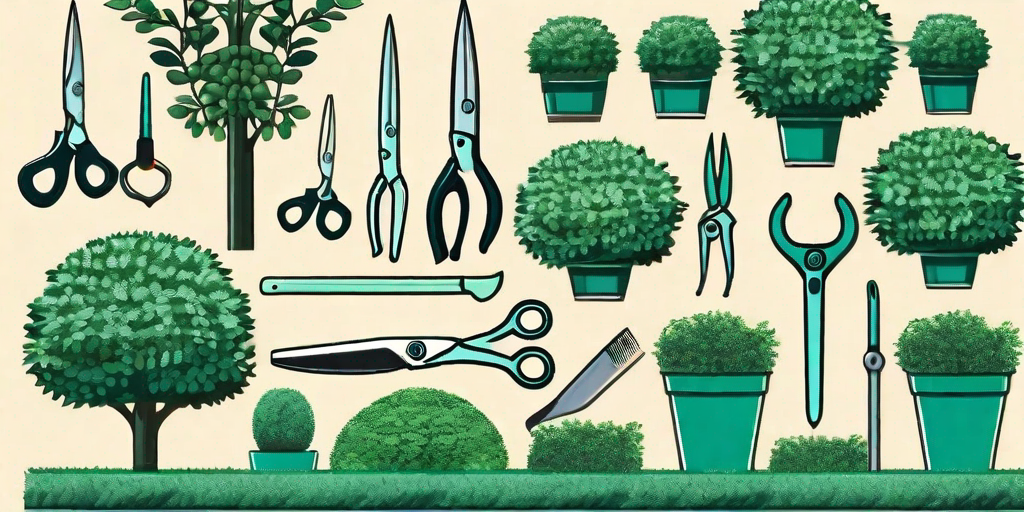
Are you ready to take your garden to the next level? Do you want to impress your neighbors with your top-notch gardening skills? Well, you're in the right place! Today, we're going to talk about boxwoods, those lovely green shrubs that can transform your garden into a verdant paradise. But not just any boxwoods, oh no. We're talking about perfectly trimmed, impeccably shaped, envy-inducing boxwoods. So, grab your gardening gloves and let's get started!
Understanding the Basics of Boxwoods
Before we dive into the nitty-gritty of trimming boxwoods, let's take a moment to appreciate these versatile shrubs. Native to Europe, Asia, Africa, and the Americas, boxwoods are known for their dense, evergreen foliage and their ability to withstand heavy pruning. This makes them a popular choice for hedges, topiaries, and other garden features.
Boxwoods come in a variety of species, each with its own unique characteristics. Some are compact and slow-growing, perfect for small gardens or containers. Others are larger and faster-growing, ideal for creating privacy screens or large hedges. Regardless of the type, all boxwoods share a common trait: they love well-drained soil and partial to full sun exposure.
Choosing the Right Boxwood for Your Garden
With so many boxwood species to choose from, how do you know which one is right for your garden? Well, it all depends on what you want to achieve. If you're looking for a low-maintenance shrub that can handle a bit of neglect, consider the Common Boxwood (Buxus sempervirens). It's hardy, drought-tolerant, and can grow up to 20 feet tall if left unpruned.
On the other hand, if you're after a compact shrub for your patio or balcony, the Dwarf Boxwood (Buxus microphylla 'Compacta') might be a better fit. It's slow-growing, reaching a maximum height of 4 feet, and its small, glossy leaves create a dense, attractive foliage.
Mastering the Art of Trimming Boxwoods
Now that you're familiar with the basics of boxwoods, it's time to roll up your sleeves and get to work. Trimming boxwoods is not just about maintaining their shape; it's also about promoting their health and vigor. So, let's get down to business and learn how to trim boxwoods like a pro.
First things first, you'll need the right tools. A pair of sharp, clean pruning shears is a must. You might also want to invest in a pair of hedge shears for larger boxwoods and a pruning saw for those tough, woody stems. And don't forget your safety gear: gloves to protect your hands and safety glasses to shield your eyes from flying debris.
When to Trim Boxwoods
The best time to trim boxwoods is in late spring, after the new growth has hardened off. This usually happens in late May or early June, depending on your climate. Trimming too early can expose the tender new growth to frost damage, while trimming too late can stimulate new growth that won't have time to harden off before winter.
That said, minor touch-ups can be done at any time of the year. Just be sure to avoid heavy pruning during periods of extreme heat or cold, as this can stress the plants and lead to disease or pest problems.
How to Trim Boxwoods
Ready to start trimming? Follow these steps to give your boxwoods a clean, professional-looking trim:
- Start by removing any dead or diseased branches. This will improve the health of the plant and make the rest of the trimming process easier.
- Next, trim the top of the boxwood to your desired height. Be sure to make your cuts just above a leaf or branch to promote new growth.
- Now, trim the sides of the boxwood, starting from the bottom and working your way up. This will ensure that the lower branches receive enough sunlight.
- Finally, step back and take a look at your work. Make any necessary touch-ups to ensure a uniform shape.
FAQs
Can I trim boxwoods in the fall?
While it's possible to trim boxwoods in the fall, it's generally not recommended. Fall pruning can stimulate new growth that won't have time to harden off before winter, making the plants more susceptible to frost damage.
How often should I trim boxwoods?
The frequency of trimming depends on the look you're going for. For a formal, manicured look, you might need to trim your boxwoods 2-3 times during the growing season. For a more natural look, once a year should be enough.
Can I trim boxwoods back hard?
Yes, boxwoods can handle a hard prune, but it should be done with care. Hard pruning can stress the plants and make them more susceptible to disease or pest problems. If you need to reduce the size of your boxwoods significantly, it's best to do it gradually over a period of a few years.
Conclusion
And there you have it, folks! Everything you need to know to trim your boxwoods like a pro. Remember, the key to successful boxwood trimming is patience and practice. So, don't be discouraged if your first few attempts don't turn out perfect. Keep at it, and before you know it, you'll be the envy of the neighborhood with your perfectly trimmed boxwoods.
So, what are you waiting for? Grab those pruning shears and get to work! Your boxwoods are waiting.















